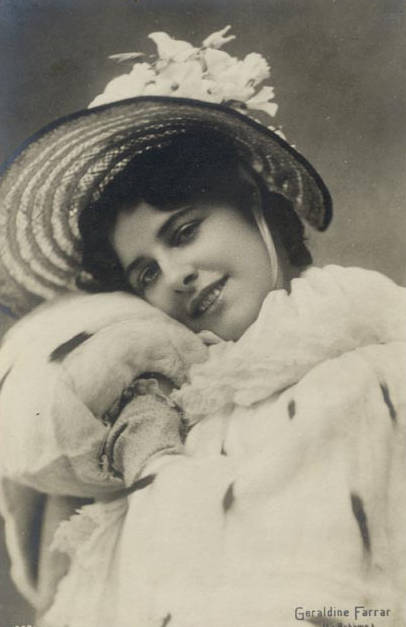Geraldine Farrar (Geraldine Farrar)

Opera Singer, Actress. A lyric soprano and opera’s first ‘Glamour Girl’, she is remembered for singing leading roles in the principal theatres of Europe and America for around 20 years. Raised in the Boston suburbs, she took to music early, began lessons at five, and started giving public recitals at 14; after early vocal education in Boston, New York, and Paris, she was trained in Berlin by legendary Wagnerian soprano Lilli Lehmann, making her 1901 professional debut there as Marguerite from Charles Gounod’s “Faust”. Notable success in Berlin and Monte Carlo followed as the title leads of Ambrose Thomas’ “Mignon”, Gounod’s “Romeo et Juliette”, and Jules Massenet’s “Manon”, as well as the March 16, 1905 Monte Carlo world premiere of Pietro Mascagni’s “Amica”. Returning to America, she made her November 26, 1906 Metropolitan Opera bow as Juliette; Gerry was to earn rave reviews for her performance as Cio-Cio-San in the 1907 Metropolitan premiere of Giacomo Puccini’s “Madame Butterfly” and her 1909 assumption of the same composer’s “Tosca”. Over the course of her career she appeared at the Metropolitan about 500 times in 29 roles including Nedda in Leoncavallo’s “I Pagliacci”, the title lead of Massenet’s “Thais”, the Goose-Girl in Englebert Humperdinck’s “Konigskinder” for which she always took curtain calls with a live goose under her arm, Elisabeth from Wagner’s “Tannhauser, and Cherubino in Mozart’s “The Marriage of Figaro”, with 95 performances of Cio-Cio-San and 58 of Georges Bizet’s ‘cigarette girl’ “Carmen” leading her list. Gerry gave several world premieres, most notably that of Puccini’s “Suor Angelica” at the Metropolitan on December 14, 1918 under the baton of Roberto Moranzoni. Always a darling of the media, she had a legion of teenage girl followers that prefigured the “rock groupies” of a later age by calling themselves “Gerry-Flappers”. Between 1915 and 1920 Gerry appeared in about a dozen silent movies, her most acclaimed parts being the lead of Cecil B. DeMille’s 1915 version of “Carmen” and Joan of Arc in 1917’s “Joan the Woman”. Her private life was colorful, with rumors of liaisons with Crown Prince (later Kaiser) Wilhelm of Germany and such musical personalities as Arturo Toscanini, Antonio Scotti, and Enrico Caruso persisting. (In response to an ultimatum, Maestro Toscanini left Gerry, the Metropolitan, and America in 1915 rather than give up his wife). Her one marriage, a 1916 union with actor Lou Tellegen, ended badly in a messy and public 1923 divorce that was followed ultimately by Tellegen’s 1934 suicide. (When told of her ex-husband’s death, she replied “Why should that interest me?”). She retired in 1922, still young but with her voice used-up by overwork in roles such as Tosca and Butterfly that were too heavy for her. She continued to sing recitals until 1931, worked for one season as a Metropolitan Opera radio commentator (famous exchange: “How does one get to sing like Rosa Ponselle?” Gerry’s answer: “By special arrangement with God.”), and wrote a rather bizarre 1938 autobiography entitled “Such Sweet Compulsion”. She lived out her days happily trading on her ‘living legend’ status and in 1960 was awarded two stars on the Hollywood Walk of Fame, though the one honoring her film career has been somehow lost, while her music star remains. Gerry died of heart disease; much of her recorded legacy, mostly cut for RCA Victor, remains available in CD format. (bio by: Bob Hufford) Family links: Parents: Sidney Douglas Farrar (1859 – 1935) Henrietta Barnes Farrar (____ – 1927)Cause of death: Heart attack
Born
- February, 28, 1882
- USA
Died
- March, 03, 1967
- USA
Cause of Death
- Heart attack
Cemetery
- Kensico Cemetery
- USA

